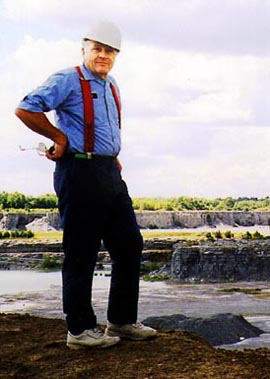|
September 8, 1998
Limestone
mine promoted as possible tourism draw
Lakeport
quarry one of North America's largest
by LORRAINE DMITROVIC
Special to The Independent
When Catherine Woodburn of Apple Vista Realty thinks
big, it's grandiose. One day three years ago, when she
trained her eye on the St. Lawrence Cement quarry in Cramahe
Township, she saw a potential tourism attraction as big
as her imagination..

|
Colborne realtor
Catherine Woodburn wants to see a tourism interpretive
centre at the Ogden Point limestone quarry.
Al Viehbacher has managed the quarry, owned
by St. Lawrence Cement, for 31 years. |
Lorraine
Dmitrovic photos |

|
Originally from Toronto, Woodburn spent weekends and
summers on her grandfather's farm near Northumberland
Heights before moving to Colborne four years ago. With
20 years in real estate and hands-on experience in general
contracting -- she's bought, renovated and sold at least
40 fixer-uppers -- Woodburn is qualified to see sparkling
potential in something ordinary and undeveloped. So
the Ogden Point limestone quarry at Lakeport, just south
of Colborne, had immediate appeal.
"St. Lawrence is apparently one of the largest open pit
limestone mining operations in North America," says Woodburn. "It's
a tourist attraction waiting to happen on a large scale.
My first thought when I saw it was 'Oh my God...' Manager
Al Viebacher drove a friend and I, 100 feet down into
the earth. Everything is immense: the size of the hole,
the trucks, front-end loaders, the crushers. Just as we
were driving in they started blasting with dynamite. It
was something to see, and you could feel quite a vibration."
Woodburn envisions weekend tours when the mine is not
in operation, although a weekday tour could be possible
with safety precautions. An information amphitheatre located
either in the Town of Colborne or at the site itself could
be part of a bus tour package. "The booth could be a tourist
attraction in itself," she says. "We could feature a videotape
showing the whole process from blasting to loading on
massive ships bound for Mississauga. The actual production
of cement is fascinating. A video walkthrough could go
through the process to the final bagged stage. Giant slabs
of limestone could be put on display. A gift shop could
sell little pieces of St. Lawrence limestone engraved
with something like 'I visited St. Lawrence Cement in
Colborne, Ontario'. People love that stuff, and it would
be a great public relations scenario for the mine itself."
Woodburn already has access to advice and information
from friends associated with tours in Sudbury and Timmins,
who've succeeded in turning 'little shack' mines into
major tourist vistas. She feels there's a built-in tourist
base because of the Apple Route connection, with the Big
Apple being the area's first big draw.
"This whole area is gearing toward more tourists who
need places to visit while on vacation," Woodburn explains. "The
St. Lawrence site would be a nice day trip from Presqu'ile
campgrounds. People would come from Toronto. Afterwards,
they'd likely come into town for a bite to eat, or mill
around the shops. It would be good for the local economy
all around."
Once begun, the tour could remain an attraction even
after the mine is exhausted, many years from now. Woodburn
has heard of plans St. Lawrence has for dynamiting the
site and turning it into an inlet. They would likely return
ownership to the town. Even that idea holds promise.
"What was once an open pit would become part of the lake.
It would make a fabulous harbour hundreds of feet deep," she
says. "Maybe we could put a new marina down there." A
beach could also be developed near the site when quarrying
is done.
Woodburn and others interested in local economic development
will draft a more detailed proposal if St. Lawrence Cement
officials warm to the idea.
Meanwhile, plant manager Al Viebacher agrees the tour
idea has potential, although to him the quarry is a hole
in the ground and a job to do.
Viehbacher has lived in Colborne and managed the Ogden
Point Quarry for 31 years. "It's a challenge to keep everything
running smoothly," he says. "I oversee everything from
equipment availability to the drilling, dynamiting, crushing
and shipping. Even though there is an element of danger,
there has not been a single fatality since the site opened
in 1959."
Viebacher says the sedimentary ore base is 500 million
years old, and is part of a formation running along the
St. Lawrence seaway north to Georgian Bay and east to
Montreal.
"The depth is 500 feet at this location," he says, "with
a final depth of 250 feet allowable in our license with
the MNR. We're presently working at 100 feet."
The ship which courses back and forth between the site
and a St. Lawrence processing plant in Mississauga carries
18,500 tons of crushed limestone each trip. 80,000 tons
is a standard weekly quota to meet.
Viehbacher estimates, according to the present MNR license
limit of extraction, there will be at least another 100
years of work at the site.
When not in operation, St. Lawrence allows fossil-hunters
in after obtaining permission to rummage through the blast
rubble. A waiver releasing the company of all liability
in the event of an accident must be signed. "In this endless
limestone, the largest fossil found was about the size
of a cigarette pack, no dinosaurs," says Viebacher.
The real dinosaurs of the site are the machinery, including
a giant pepper mill-like rock crusher, with a mouth twelve
feet wide. Tires on the quarry's trucks dwarf a six-foot
man, and the bucket on a front-end loader could easily
transport the family car.
Viebacher likes to survey the property now and then,
often from a precarious peak high on a conveyor.
"For some people, the quarry might be something worthwhile
to see," he says. "Beauty is in the eye of the beholder."
|
![]()
![]()
![]()